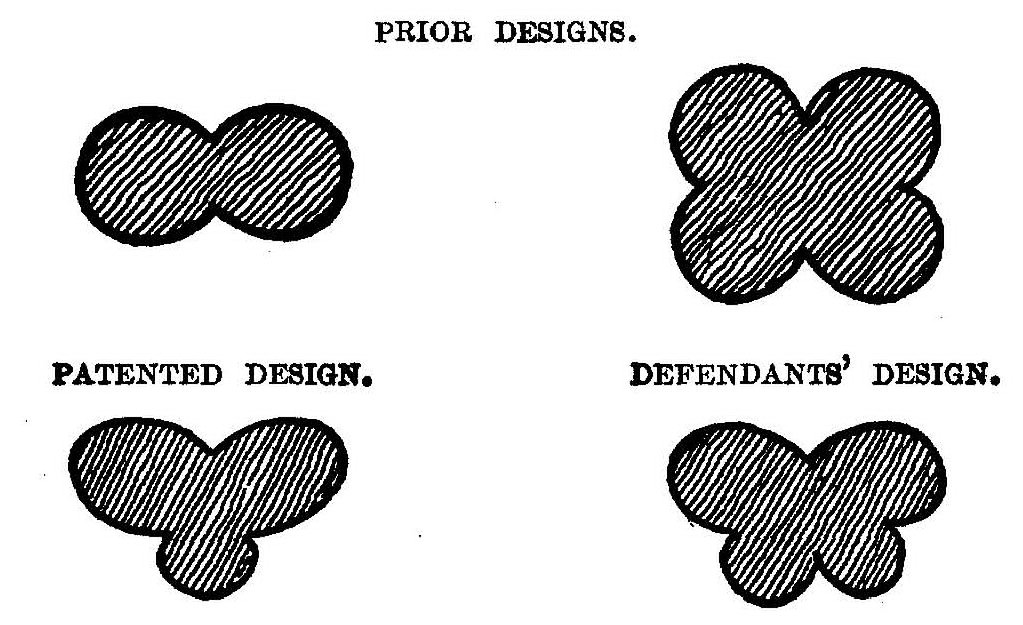
SUTRO BROS. BRAID CO. v. SCHLOSS et al.
Circuit Court, S. D. New York.
November 18, 1890.
PATENTS FOR INVENTION—DESIGN FOR BRAID—INFRINGEMENT.
Letters patent No. 18,589, granted to Valentine Schuck, September 4, 1888, for a design for braid covers, a design having when seen in cross-section, two extended flattened elliptical curves diverging at an obtuse angle from each other, with a third rib projecting from the center in the form of a convex curve, and smaller than the others, presenting the appearance of a trefoil. Held, not infringed by a braid made in two colors, and having four ribs, the two lower ones being smaller than the others.
In Equity.
David A. Burr, for complainant.
Alfred Ely, for defendants.
COXE, J. This is an equity suit for the infringement of letters patent No. 18,589, granted September 4, 1888, to Valentine Schuck, assignor to complainant, for a design for braid, used in trimming ladies' garments and for similar purposes. The design shows a deep, central groove indenting one face of the braid, the opposite face being rounded and crowned with a slight, central, longitudinally projecting rib. In cross-section the design has the appearance of a trefoil or three-leafed clover, with the lower leaf smaller than the other two. The claim is as follows:
“The design for a piece of braid herein shown and described, which consists in the form imparted thereto, which is defined in cross-section by two extended flattened elliptical curves diverging at an obtuse angle from each other to form a central re-entrant angle or cusp at their intersection on one side, and which terminate on the opposite side in the intersecting lines of a central outwardly projecting convex curve of small diameter.“
The defenses are lack of patentable novelty, non-infringement and that the patent is invalid because the claim is indefinite and functional. The 357claim covers a design having, when seen in cross-section, the following characteristics:
First. Two extended, flattened, elliptical curves diverging at an obtuse angle from each other to form a central cusp at their intersection on one side. Second. On the side opposite the cusp, a central rib, projecting outwardly in the form of a convex curve. Third. This convex curve must be of small diameter when compared with the other curves. That is, it must be of smaller diameter than the oblate curves.
Prior to the patent, braids had been made in various forms. The old soutache braid resembled the design of the patent minus the longitudinally projecting rib upon the lower side. Braid had also been made with four ribs of equal size. The defendants' braid is made of two colors—black and bronze—and presents the appearance of having four ribs, the two lower ribs being smaller than the two upper ones. The situation can be better illustrated by placing enlarged cross-sections of these various designs in juxtaposition:

It will be seen that in view of the prior art a broad construction of the claim is out of the question. A braid which does not present to the eye the characteristics so distinctly enumerated in the claim, namely, a three-ribbed design, in conformation like a trefoil, does not infringe. The test of infringement where design patents are under consideration is the substantial identity in effect produced by the two designs in question upon the eye of a general observer interested in such matters or an ordinary purchaser of articles embodying similar designs. If he be not deceived, if it be entirely plain that he could not be induced to take the defendants' goods for the complainant's, there is no infringement. Walk. Pat. § 375. Tested by this rule the court is constrained to hold that the defendants do not infringe. If a purchaser should start out with the express intention of buying braid made after the design of the patent, it is not conceivable that he would buy the defendants' braid, and there is absolutely no proof that any one was ever so deceived. In appearance it is entirely different from the complainant's. The use of two colors conveys to the eye the impression of four ribs—instead of the three ribs 358of the patent. The defendants' braid certainly looks as if it had four ribs, and, if the testimony of the patentee can be relied upon, it, in fact, has four ribs. Mr. Schuck was asked on cross-examination the following questions:
“Question. Will you take this exhibit [defendants' braid] and say how many ribs there are on that? Answer. There are four.”
On his redirect examination he emphasized his former answer as follows:
“Q. In your answer to cross-question 99 you were asked to take defendants' braid and see how many ribs there are in it, and answered ‘There are four,’ what do you understand the question to refer to? A. I understood it referred to? Q. What are ribs as you understand in the defendants' braid? A. Those corners of the braid I called ribs; there are four ribs on that, two small and two large ones.”
After all this, the theory that the defendants' braid has but three ribs cannot be maintained. As the defendants do not infringe it is unnecessary to examine the other questions presented. The bill is dismissed.
This volume of American Law was transcribed for use on the Internet
through a contribution from Google. 